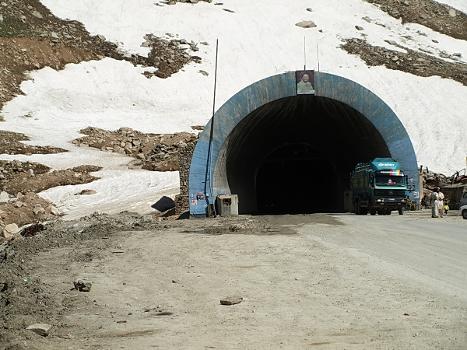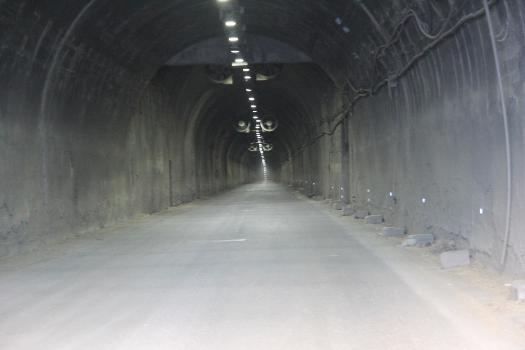General Information
| Completion: | 1964 |
|---|---|
| Status: | in use |
Project Type
| Structure: |
Tunnel |
|---|---|
| Function / usage: |
Road tunnel |
Location
| Location: |
Baghlan, Afghanistan Parwan, Afghanistan |
|---|---|
| Coordinates: | 35° 18' 23.37" N 69° 2' 50.17" E |
| Coordinates: | 35° 19' 18.90" N 69° 1' 36.94" E |
Technical Information
Dimensions
| length | 2 600 m |
Excerpt from Wikipedia
The Salang Tunnel (Dari: تونل سالنگ Tūnel-e Sālang, Pashto: د سالنگ تونل Da Sālang Tūnel) is a 2.67-kilometre-long (1.66 mi) tunnel located at the Salang Pass in the Hindu Kush mountains, between the Parwan and Baghlan provinces of Afghanistan, about 90 kilometers north of the city of Kabul. Nearly 3,200 m (10,500 ft) above sea level, it was completed by the Soviet Union in 1964 and connects northern Afghanistan with the capital, Kabul, and southern parts of the country. The Salang Tunnel is of strategic importance and is the only pass going in a north–south direction to remain in use throughout the year, although it is often closed during the cold winters by heavy snowfall.
Overview
The tunnel represents the major north–south connection in Afghanistan, cutting travel time from 72 hours to 10 hours and saving about 300 kilometres (190 mi). It reaches an altitude of about 3,400 metres (11,200 ft) and is 2.6 kilometres (1.6 mi) long. The width and height of the tunnel tube are 7 metres (23 ft). Other sources say that the tunnel is no more than 6.1 metres (20 ft) wide at the base and 4.9 metres (16 ft) high, but only in the centre.
It was noted in 2010 that about 16,000 vehicles pass through the Salang Tunnel daily. Other reports say that the tunnel was designed for 1,000 vehicles a day, but is now handling seven to ten thousand vehicles a day.
It forms part of the Highway 1 (Ring Road).
History
In 1955, Afghanistan and the Soviet Union signed an agreement to initiate joint development of the Salang road, initially via the historic Salang Pass route. The tunnel was opened in 1964 and provided a year-round connection from the northern parts of the country to Kabul. The tunnel was the highest road tunnel in the world until 1973, when the United States built the Eisenhower Tunnel — just slightly higher and slightly longer — in Colorado in the Rocky Mountains.
A ventilation system was built in 1976.
It is known for a deadly fire that occurred in November 1982, and several avalanche incidents. A series of avalanches led to the deaths of as many as 172 people in February 2010 either as a direct result of the avalanche or through being trapped.
After the 1989 Soviet withdrawal from Afghanistan, maintenance suffered, and eventually, in the course of combat between the Afghan Northern Alliance and the Taliban in 1997–1998, the tunnel's entrances, lighting and ventilation system were destroyed, so that it could only be transited by foot in the dark. After the overthrow of the Taliban-led government, a joint effort between agencies from Afghanistan, France, Russia, the United States and others cleared the mines and debris and reopened the tunnel on January 19, 2002.
In the early 2010s it was still receiving ISAF funding for repair and renovation. Between seven and ten thousand vehicles currently pass through the tunnel each day.
In 2012, the United States Agency for International Development (USAID) made a technical study for a new tunnel reaching from the Olang region in Parwan province to DoShakh in Baghlan province, going through the mountains of the Hindu Kush, further than the current tunnel. The design shortened travel distance by 30 to 40 km (19 to 25 mi).
Incidents
1980 accident
During the Soviet-Afghan war, the tunnel was a crucial military link to the south, yet was prone to ambushes by the Afghan mujahideen fighters. On February 23, 1980 as a result of a road traffic accident, a Soviet army convoy was trapped and 16 of its servicemen suffocated from exhaust gases.
1982 fire
On November 3, 1982 the Salang tunnel fire killed 64 Soviet soldiers and 112 Afghans; apparently after a collision, a tanker truck blew up in the tunnel, and the fire engulfed a military convoy. Other sources offer some variation in the number of fatalities, although the Guinness Book of World Records 2007 cites the same figure of "about 176" fatalities.
2002 avalanche
Several weeks after reopening several hundred people were trapped in the tunnel due to an avalanche at its southern end. While most people were rescued, fatalities occurred due to asphyxiation and freezing. After further rehabilitation, in July 2004, the tunnel could carry two-way traffic.
2009 avalanches
Avalanches in the approach to the tunnel killed at least ten people in January 2009.
2010 avalanches
On February 8, 2010, a series of at least seventeen avalanches struck the area around the tunnel, burying miles of road, killing dozens of people and stranding hundreds more. Hundreds of cars were buried in the snow. More than 150 people are expected to have been killed in total, according to officials. At least 400 injuries were reported.
The Afghan National Army and NATO used their helicopters to rescue at least 2,500 people who were trapped inside their vehicles.
The avalanches were caused by a sudden blizzard that struck the area, closing the tunnel and the roads around it on both side of the tunnel.
The tunnel was reopened on February 12, 2010.
Text imported from Wikipedia article "Salang Tunnel" and modified on 4 April 2022 according to the CC-BY-SA 3.0 license.
Participants
Currently there is no information available about persons or companies having participated in this project.
Relevant Web Sites
- About this
data sheet - Structure-ID
20032833 - Published on:
01/11/2007 - Last updated on:
24/06/2022







